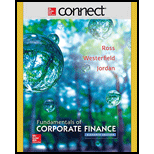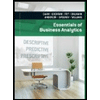
Capital Budgeting [LO2] Lakonishok Equipment has an investment opportunity in Europe. The project costs €10.5 million and is expected to produce cash flows of €1.7 million in Year 1, €2.4 million in Year 2, and €3.3 million in Year 3. The current spot exchange rate is $1.36/€; the current risk-free rate in the United States is 2.3 percent, compared to that in Europe of 1.8 percent. The appropriate discount rate for the project is estimated to be 13 percent, the U.S. cost of capital for the company. In addition, the subsidiary can be sold at the end of three years for an estimated €7.5 million. What is the
To find: The net present value of the project.
Introduction:
International capital budgeting estimates the decisions on investment that are related to the changes in the rate of exchange. There are two methods under international capital budgeting which are as follows:
Home currency approach:
In this approach, “Net present value (NPV)” is ascertained on converting “foreign cash flows” into domestic currency.
Foreign currency approach:
In this approach, “foreign discount rate” is computed to find net present value of foreign cash flows. Then net present value is converted into dollars.
Answer to Problem 14QP
The net present value is $687,680.90.
Explanation of Solution
Given information:
The Company L that manufactures equipment has an investment opportunity in Country E. The cost of the project is €10.5 million, the expected cash follow in the year 1 is €1.7 million, in the year 2 is €2.4 million, and in year 3 is €3.3 million.
The present spot exchange rate is $1.36 for a euro, the present risk-free rate in Country U is 2.3% compared to Country E is 1.8%. The current rate of discount for a project is 13%, Country U cost of capital for the company.
Computation of the net present value of the project:
The net present value is computed by the following steps:
- At first, it is essential to determine the expected exchange rate for the corresponding 3 years by dividing one plus Country U’s nominal risk-free interest rate with one plus Continent E nominal risk-free interest rate by the power value of subsequent year then multiply it by spot rate.
- Secondly, it is essential to determine the dollar cash flows by multiplying expected exchange rate of the corresponding years with subsequent years project cost.
- Finally, determine net present value with the computed dollar cash flows.
Formula to calculate the expected exchange rate:
E (S1) refers to “expected exchange rate” in t periods
RUS refers to Country U’s nominal risk-free interest rate
RFC refers to foreign country nominal risk-free interest rate
t refers to number of years
Computation of the expected exchange rate for year 1:
Hence, the expected exchange rate for year 1 is $1.366679764 for a €.
Computation of the expected exchange rate for year 2:
Hence, the expected exchange rate for year 2 is $1.37339233675 for a €.
Computation of the expected exchange rate for year 3:
Hence, the expected exchange rate for year 2 is $1.3801378786 for a €.
Formula to calculate the dollar cash flows:
Computation of the dollar cash flows in the initial year:
It is given that, expected project cost is €10,500,000 and $1.36/€ is current spot rate.
Hence, the dollar cash flow in the year 0 is - $14,280,000.
Computation of the dollar cash flows in the year 1:
It is given that, the expected cash flow is €1,700,000 in year 1and computed “expected exchange rate” for year 1 is $1.366679764/€.
Hence, the dollar cash flow in the year 1 is $2,323,355.598.
Computation of the dollar cash flows in the year 2:
It is given that, “expected cash flow” is €2,400,000 in year 2 and computed “expected exchange rate” for year 2 is $1.37339233675/€.
Hence, the dollar cash flow in the year 2 is $3,296,141.60.
Computation of the dollar cash flows in the year 3:
It is given that, “expected cash flow” is €3,300,000 in year 3, subsidiary are sold for €7,500,000 of year 3, and computed expected exchange rate for year 3 is $1.3801378786/€.
Hence, the dollar cash flow in the year 3 is $14,905,489.08.
The dollar cash flows for the subsequent years:
| Year | Dollar cash flows |
| 0 | –$14,280,000 |
| 1 | $2,323,355.60 |
| 2 | 3,296,141.60 |
| 3 | $14,905,489.08 |
Computation of the net present value:
Hence, the net present value is $687,680.90.
Want to see more full solutions like this?
Chapter 21 Solutions
Connect 1 Semester Access Card for Fundamentals of Corporate Finance
- Which type of bond offers tax advantages? A) Convertible bondsB) Municipal bondsC) Corporate bondsD) Junk bondsarrow_forwardWhat does "liquidity" refer to in finance? A) The profitability of a companyB) The ease of converting assets to cashC) The value of fixed assetsD) The number of outstanding shares i need answer.arrow_forwardNo chatgpt! What does "liquidity" refer to in finance? A) The profitability of a companyB) The ease of converting assets to cashC) The value of fixed assetsD) The number of outstanding sharesarrow_forward
- What is the main purpose of budgeting in a company? A) To eliminate all expensesB) To forecast and control costsC) To increase revenueD) To reduce taxesarrow_forwardWhat does "liquidity" refer to in finance? A) The profitability of a companyB) The ease of converting assets to cashC) The value of fixed assetsD) The number of outstanding sharesarrow_forwardI need answer in this problem quickly. The Weighted Average Cost of Capital (WACC) includes: A) Cost of equity and cost of debtB) Only the cost of equityC) Only the cost of debtD) Total revenue of the companyarrow_forward
- Help me in this question. The Weighted Average Cost of Capital (WACC) includes: A) Cost of equity and cost of debtB) Only the cost of equityC) Only the cost of debtD) Total revenue of the companyarrow_forwardNeed answer! The Weighted Average Cost of Capital (WACC) includes: A) Cost of equity and cost of debtB) Only the cost of equityC) Only the cost of debt D) Total revenue of the companyarrow_forwardThe Weighted Average Cost of Capital (WACC) includes: A) Cost of equity and cost of debtB) Only the cost of equityC) Only the cost of debtD) Total revenue of the companyarrow_forward
- Which of these is NOT part of the 4Ps in marketing but relevant to finance? A) PriceB) PromotionC) PlaceD) Profitabilityarrow_forwardI need correct answer. If a bond’s price increases, its yield will: A) IncreaseB) DecreaseC) Remain the sameD) Be unpredictablearrow_forwardWhat is the primary goal of financial management? A) Maximizing revenuesB) Minimizing costsC) Maximizing shareholder wealthD) Increasing market share need help!arrow_forward
 Essentials Of Business AnalyticsStatisticsISBN:9781285187273Author:Camm, Jeff.Publisher:Cengage Learning,
Essentials Of Business AnalyticsStatisticsISBN:9781285187273Author:Camm, Jeff.Publisher:Cengage Learning,

